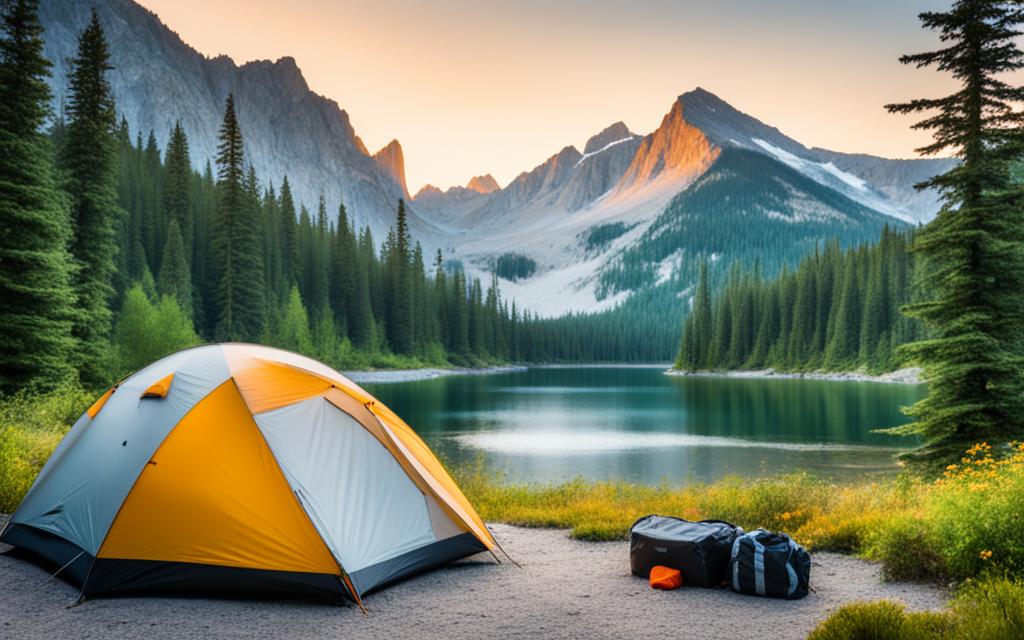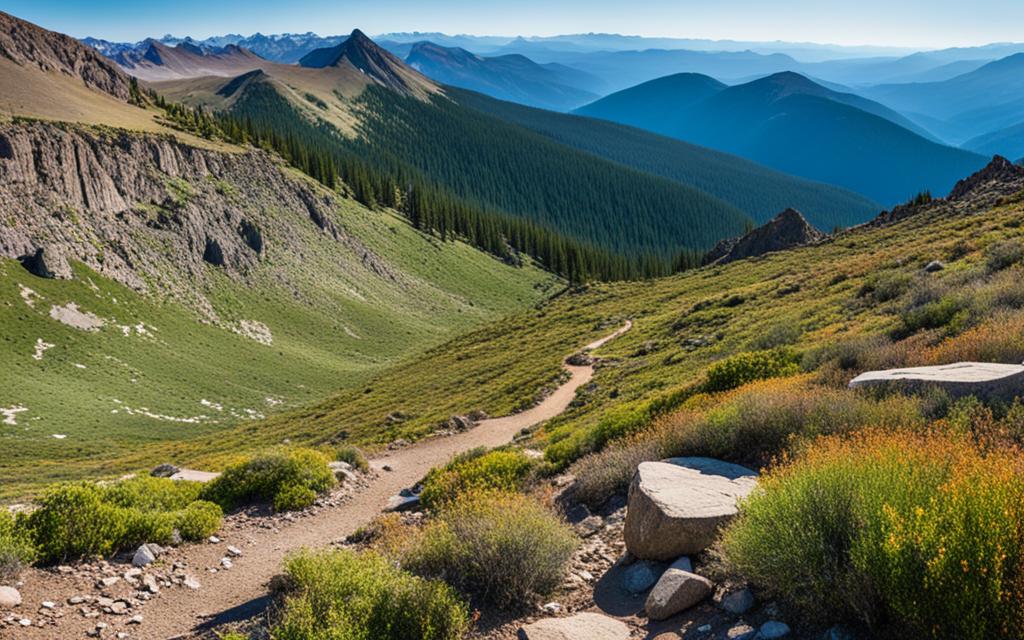The Leave No Trace principles offer a simple way to reduce our impact on nature. They apply everywhere, from deep in the wilderness to your backyard. Each principle focuses on a specific area and gives us the tools to protect our environment.
These guidelines are based on the latest science and advice from experts. By following them, we help keep nature safe for everyone now and in the future.

Table of Contents
Key Takeaways
- The Leave No Trace principles offer a comprehensive framework for responsible outdoor recreation and environmental stewardship.
- These principles can be applied in a wide range of settings, from remote wilderness areas to local parks, to minimize our impact on the natural world.
- The principles are continuously updated to reflect the latest research and best practices in conservation, outdoor education, and sustainable recreation.
- By adhering to the Leave No Trace principles, we can contribute to the preservation of natural resources for present and future generations.
- The principles empower individuals to make informed decisions and take practical actions to reduce their environmental footprint during outdoor activities.
What are the Leave No Trace Principles?
The Leave No Trace principles guide us in enjoying the outdoors responsibly. They offer seven core guidelines to help us leave nature as we found it. This way, we can enjoy nature without harming it for others.
Understanding the Seven Core Principles
- Plan Ahead and Prepare: Proper planning makes adventures safer. It helps campers know the area and weather, making them better prepared.
- Travel and Camp on Durable Surfaces: This rule helps protect the land. Campers should use surfaces like rock, gravel, sand, or dry grasses.
- Dispose of Waste Properly: It’s important to take all trash and leftover food with you. For human waste, dig a hole 6 to 8 inches deep, 200 feet from water.
- Leave What You Find: Visitors should not disturb natural or cultural resources. This keeps the wilderness safe for the future.
- Minimize Campfire Impacts: Using camp stoves instead of fires helps reduce the need for firewood and environmental damage.
- Respect Wildlife: Keep a safe distance from wildlife and don’t feed them. This protects their health and natural behavior.
- Be Considerate of Other Visitors: Quiet travel and camping keeps the outdoor experience enjoyable for everyone.
By sticking to these seven principles, we can enjoy Leave No Trace camping, responsible camping, low-impact hiking, and sustainable outdoor recreation. This way, our love for nature is matched with caring for the environment and wilderness ethics.
Plan Ahead and Prepare
Proper trip planning and preparation is key for a great outdoor adventure. By planning ahead and preparing, we can safely reach our goals and protect nature. It’s important to plan our trips during off-peak times, get the right permits, and know the area’s geography and weather.
Good meal planning, picking the right gear, and checking our skills make our trips better. They make them more fun and environmentally responsible. Following Leave No Trace camping and low-impact hiking helps us leave less of a mark. This supports sustainable outdoor recreation and environmental stewardship.
- Follow group size rules and wilderness ethics to protect nature.
- Plan your food and choose light, minimal-impact meals to reduce waste.
- Learn about the weather, terrain, and other factors to help backcountry conservation and nature preservation.
- Get the needed permits and know the rules to avoid legal issues and green adventuring problems.
By planning ahead and preparing, we can go on our outdoor adventures with confidence. We’ll know we’re protecting the natural beauty for others to enjoy in the future.

“Good trip planning is the foundation for a successful and responsible outdoor adventure.”
Travel and Camp on Durable Surfaces
Exploring the outdoors should be done with care for the environment. A key rule of Leave No Trace is to travel and camp on durable surfaces. This keeps fragile ecosystems safe and lets future generations enjoy nature’s beauty.
Concentrating or Dispersing Impact
In busy areas, stick to trails and campsites where plants are already gone. This stops new trails and campsites from forming. Keeping campsites small and tents close reduces our impact.
But in quiet, less-traveled places, spreading out is better. Take different paths, use various spots for tents and cooking, and move your camp daily. This keeps the area looking natural.
Always pick the toughest surfaces to walk on, like rock, gravel, sand, or hard soil. These can handle a lot of foot traffic without getting damaged.
By camping with Leave No Trace in mind, we can enjoy nature without harming it. This way, we keep these beautiful places safe for others to enjoy later.

Leave No Trace Camping: Dispose of Waste Properly
When it comes to Leave No Trace camping, getting rid of waste right is key. The rule is simple: “pack it in, pack it out.” This way, we don’t leave any trace of our visit in the backcountry.
Packing Out Trash and Properly Disposing of Waste
We must check our campsites, where we prepare food, and rest spots for trash. We should collect and pack out all trash, leftover food, and any litter. For human waste, dig catholes that are 6-8 inches deep, away from water, trails, and campsites.
Also, any wastewater from cooking and cleaning should be strained. Disperse it at least 200 feet from water sources. Use only small amounts of biodegradable soap.
Following these waste disposal rules helps prevent disease and protects nature. Over 100 harmful organisms can be found in human waste, including Giardia and Hepatitis A virus. Twenty-five percent of National Park managers say human waste disposal is a big issue in backcountry areas. In some places, all solid human waste must be taken out.
Planning our meals and packing out trash helps us leave no trace. Items like plastic bags and fishing line can harm wildlife and the environment. Remember, “pack it in, pack it out” is key for Leave No Trace camping and sustainable outdoor recreation.
Leave What You Find
When we go outdoors, it’s key to follow the Leave No Trace principle. This means we don’t take rocks, plants, animals, or other items from nature. By just looking and not touching, we help keep the environment untouched for others.
Small actions can have big effects on nature. Picking a few flowers might seem okay, but many people doing it can harm ecosystems and pollinators. Taking things like antlers or rocks home can also ruin the experience for others.
We must respect cultural and historical artifacts too. It’s okay to look at them, but taking them away is illegal and can destroy history. Letting others find these items as we did is important.
Don’t change a campsite by digging or damaging plants. These actions harm the environment and ruin the wilderness feel. We should leave the area just as we found it, keeping the ecosystem safe for the future.
Following Leave No Trace helps protect nature and its history. Our actions today affect the future of outdoor adventures. It’s our duty to keep the natural world beautiful for everyone.
Conclusion: Minimizing Our Impact for Future Generations
By following the seven core principles of Leave No Trace, we can help protect our natural spaces for everyone now and in the future. These guidelines help us reduce our impact on the environment. They keep the wilderness experience pure and teach us to value nature’s beauty and its fragility.
As more people enjoy Leave No Trace camping and hiking, it’s key we all adopt a mindset of minimal impact. This way, we can keep the outdoors beautiful for all to enjoy.
Our efforts in sustainable outdoor activities and conservation can keep nature untouched for the future. By sticking to Leave No Trace, we can cut soil erosion by 92%, reduce trail damage by 81%, and lower water pollution by 70%. This makes a big difference in keeping nature safe for future generations.
Professionals like park rangers and guides have a big role in teaching others about caring for nature. By setting an example and promoting Leave No Trace, we can keep our natural areas untouched and open for everyone. This lets people from all over connect with nature’s beauty and peace.
FAQ
What are the Leave No Trace principles?
The Leave No Trace principles offer seven core guidelines for outdoor activities. These guidelines help us reduce our environmental impact. They include: 1) Plan Ahead and Prepare, 2) Travel and Camp on Durable Surfaces, 3) Dispose of Waste Properly, 4) Leave What You Find, 5) Minimize Campfire Impacts, 6) Respect Wildlife, and 7) Be Considerate of Other Visitors. These principles help us protect nature and ensure a great experience for everyone.
Why is it important to plan ahead and prepare for outdoor activities?
Planning your outdoor trip is crucial for safety and enjoyment. It helps you avoid surprises and follow the rules. You should plan to avoid busy times and get any needed permits. Knowing the area’s weather and geography is also key.
Choosing the right meals and gear, and making sure you have the right skills, makes your trip better. This way, you can have a fun, low-impact adventure.
How can we minimize our impact when traveling and camping in the outdoors?
To reduce damage to the land, stick to trails and designated campsites. This helps prevent soil erosion and protects plants. In less-traveled areas, spread out your impact by taking different paths and moving your camp often.
Always use durable surfaces like rock or sand for camping. This helps protect the environment.
How should we properly dispose of waste while camping or hiking?
Always remember “pack it in, pack it out” to dispose of waste correctly. Check your campsite for trash and pack it out. For human waste, dig a hole 6-8 inches deep at least 200 feet away from water and trails.
Strain and spread out cooking and cleaning water at least 200 feet from water sources. Use biodegradable soap in small amounts. Proper waste disposal prevents disease and protects nature.
What does it mean to “Leave What You Find” in the outdoors?
“Leave What You Find” means don’t touch or remove natural or cultural items. Don’t disturb plants, animals, or historical sites. If you see cultural artifacts, look but don’t touch them. They might be protected by law.
Avoid changing a campsite by digging or damaging plants. This helps keep the outdoors wild and untouched for others.
